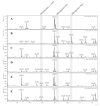Unveiling the Emergence and Genetic Diversity of OXA-48-like Carbapenemase Variants in Shewanella xiamenensis
- PMID: 37317299
- PMCID: PMC10223020
- DOI: 10.3390/microorganisms11051325
Unveiling the Emergence and Genetic Diversity of OXA-48-like Carbapenemase Variants in Shewanella xiamenensis
Abstract
An increase in the carbapenem-hydrolyzing capacity of class D β-lactamase has been observed in strains of multiple species, posing a significant challenge to the control of antibiotic resistance. In this study, we aimed to investigate the genetic diversity and phylogenetic characteristics of new blaOXA-48-like variants derived from Shewanella xiamenensis. Three ertapenem-non-susceptible S. xiamenensis strains were identified, one isolated from the blood sample of an inpatient, the other two isolated from the aquatic environment. Phenotypic characterization confirmed that the strains were carbapenemase producers and exhibited antimicrobial resistance patterns to ertapenem, with some showing lower susceptibility to imipenem, chloramphenicol, ciprofloxacin, and tetracycline. No significant resistance to cephalosporins was observed. Sequence analysis revealed that one strain harbored blaOXA-181 and the other two strains harbored blaOXA-48-like genes, with open reading frame (ORF) similarities with blaOXA-48 ranging from 98.49% to 99.62%. The two novel blaOXA-48-like genes, named blaOXA-1038 and blaOXA-1039, respectively, were cloned and expressed in E. coli. The three OXA-48-like enzymes demonstrated significant hydrolysis activity against meropenem, and the classical β-lactamase inhibitor had no significant inhibitory effect. In conclusion, this study demonstrated the diversity of the blaOXA gene and highlighted the emergence of novel OXA carbapenemases in S. xiamenensis. Further attention to S. xiamenensis and OXA carbapenemases is recommended for the effective prevention and control of antibiotic-resistant bacteria.
Keywords: OXA-48-like; S. xiamenensis; carbapenem hydrolysis activity; oxacillinases.
Conflict of interest statement
The authors declare no conflict of interest.
Figures




References
Grants and funding
LinkOut - more resources
Full Text Sources

